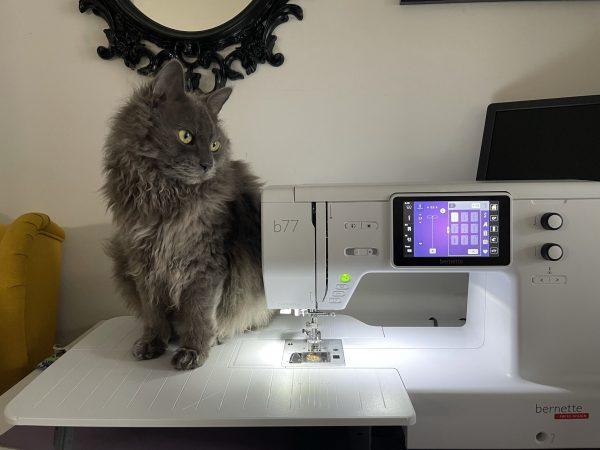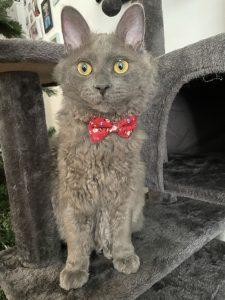-
About
- Leadership & Faculty
- News & Events
-
Academics
- Graduate
- Advanced Clinical Training
- Continuing Education
- Academic Offices
-
Student Life
-
Research
-
Hospitals & Clinics
- Emergency Care
- Hospital Services
-
Community Outreach
- Volunteer
Foster Hospital Performs First Middle Ear Ultrasound on a Cat
Specialized technique helps feline overcome chronic ear infections

Rescued as a feral kitten living in a barn two years ago, Brittany Ray adopted Walnut when he was two months old.
“He’s my work supervisor,” Brittany jokes. “He loves napping on my desk.”
Walnut also likes to sit with Brittany while she sews, often sleeping on her fabrics. While their bond formed quickly, Walnut’s health was an underlying issue. Brittany noticed a lump behind his ear when he first came home. Diagnosed by a veterinarian with a bilateral ear infection, Walnut’s right ear recovered, and the cyst resolved with antibiotics, but his left ear never fully cleared and developed frequent recurrent infections.
Brittany took Walnut to a number of specialists, and despite repeated treatments with antibiotics, the ear infections persisted. Her veterinarian recommended Foster Hospital for Small Animals at Cummings School. She brought Walnut to Foster Hospital in November 2021.
“The doctors spent a whole day with Walnut. Most veterinary appointments are 30 minutes. They really cared about Walnut as a patient,” says Brittany.
Ramon Almela, Ph.D., D.V.M., DECVD, DEBVS; Tim Chan, BVMS, and the rest of the dermatology team at Foster Hospital treated Walnut and immediately noticed him scratching, shaking, and tilting his head—signs of chronic ear issues, indicating inner ear involvement. Because the ear was filled with fluid, Dr. Almela could not get a clear view of the canal and eardrum. CT scans are typically recommended to view the middle and inner ear in cats.
“Another option is an ultrasound. It doesn’t require general anesthesia, it’s noninvasive, less expensive, and faster,” Dr. Almela explains.
However, very few radiologists are trained to perform ultrasounds of the middle ear on cats, so the procedure is not widely available.
“We were lucky to have access to this technique,” Dr. Almela contends. “Foster Hospital radiologist Agustina Anson Fernandez, D.V.M., Ph.D., DECVDI, trained for this type of ultrasound at the University of Veterinary Medicine in Vienna [Austria]. We contacted her and discussed the case, and she agreed to perform the procedure on Walnut.”
Walnut was the first cat at Foster Hospital to have an ultrasound of both ears. Dr. Almela diagnosed Walnut with an infection of the middle ear that spread to the inner ear.
Walnut was treated with ear drops, a supplemental wash, and two antibiotics based on culture and sensitivity and the cat’s previous antibiotic treatments. The new treatments showed immediate results.
“He’s like a completely new cat,” says Brittany. “He’s never jumped before, and now he pounces. He’s running around like crazy, more vocal, and constantly playing with our other cat. He used to be quiet and slept a lot.”
Brittany appreciated the follow-up emails from Dr. Almela to check on Walnut and the benefits of taking their cat to a teaching hospital.
“The students were fantastic and so caring,” she remarks. “They called before the appointment and spoke with me for almost an hour to record Walnut’s medical history.”
Dr. Almela will recheck Walnut later this month to see if the middle ear infection is completely resolved. If not, he will flush it to clean out the ear canal. Dr. Almela also plans to conduct research about performing ultrasounds on cats in similar situations in lieu of CT scans.
“I highly recommend Foster Hospital,” Brittany shares. “The doctors were kind, inquisitive, and caring. They took interest in and spent time with Walnut, they were not just treating him. Their team has been amazing.”
Department:
Foster Hospital for Small Animals
